
| Related pages: |
Females are quite happy to oviposit in captivity, and do so at dusk during their normal flight hours. Eggs are placed in a masses of 10 to 25 eggs per night. Up to 50 eggs per female have obtained over several nights. They hatch reliably at 21 days from the time they were oviposited. Below are shown the eggs and hatching larvae on August 6, 2004
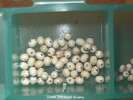
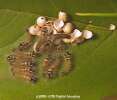
A number of listed host plants were tested, including plants found near the point of capture. At first they didn't seem interested in any of the choices presented, but finally began feeding on Pine - which was abundant at the the capture site.
Early instar larvae are gregarious, resting in tightly-packed bunches of 50 or more. Inactive most of the time, they come to life, usually at dusk, and scatter to nearby pine needles.
Feeding behavior is quite interesting - fast and frenzied, with 2 or 3 larvae sharing a single pine needle, apparently helping each other peel it like a banana as they work backwards from the tip towards the base. The two pictures below show pairs of larvae eating together. Photos taken around August 10, 2004.
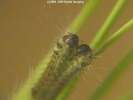

After a 20-30 minute feeding frenzy, they return to their chosen clustering location to rest until the next feeding session, at least several hours away, but probably not until the next day.
The larvae are quite hairy and colorful. When tightly packed during inactivity, they appear to be a solid grey mass, looking somewhat like a thick glob of spider web or other debris. However, they spin surprisingly little silk considering the family that they belong to (tent caterpillars). The color and texture of the mass is largely a product of the hairs and larval skin coloration, which blends surprisingly well with the pine bark and stalk color. Photos taken October 20, 2004.

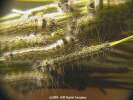

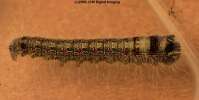
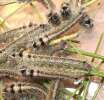
After nearly two months, the oldest larvae are barely into the 3rd instar. This fact, coupled with the short and infrequent feeding sessions, indicates that this species may take 6 months or longer to complete the larval phase of its life cycle.
These photos were taken on November 7, 2004. The larvae continue to grow slowly but other than a moderate increase in size have not changed much. They still feed shortly after dusk for up to an hour and then return to a cluster to wait until the next day.
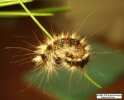
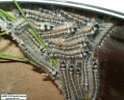
The only break in this pattern appears to be just prior to molting, when they become inactive for 2 or more days before shedding their skins. Molting appears to synchronized, either chronologically or perhaps pheromonally stimulated. An entire group of about 100 siblings molted within a 1-2 day period. It should be noted that this group of 100 originated from up to three different females, but were all oviposited on the day, and also hatched at the same time, 21 days later.
These shots were taken on November 30, 2004. Slow but consistent growth continues, and the larvae are now about 1.25" in length at this point.



This series was shot January 20, 2005. Slow growth continues. These images show how the larvae pack together tightly during the non-feeding hours. This mass contains about 100 larvae. They seem quite hearty and none have died up to this point. Fortunately, Pine cuttings stay fresh enough in water to last up to 20 days before needing to be changed, allowing relatively low maintenance over the long larval growth cycle.



March 12, 2005 They seem to be growing a little faster now - and eating more! All of the larvae in container 1 (18 of about 125) were relocated to a sleeve on one of the host trees. Hopefully they'll be able to eat for longer periods without needing fresh host.




On 3-20-2005 the larvae of container 1 was relocated to a sleeve outdoors. The two sleeved groups are shown below. Container 2, with just less than 100 larvae, is still being kept indoors and refreshed with new pine cuttings in water every 10-20 days. All the larvae appear to be doing well.


On 5-2-2005, these larvae are looking pretty fat and furry. Some are close to 3" long now and consume considerably more pine needles than earlier in the year. They are growing rapidly, even though their feeding habits haven't changed much. They still begin feeding a dusk, and continue for an hour or so before returning to their resting area to "nest" in a mass.


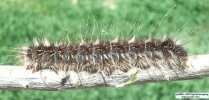
5-26-2005 I was surprised to find one cocoon in the indoor cage. The host plant had been drying out for a while and perhaps this triggered the early pupation. Or, perhaps it was just the right time for this individual. The pupa is small, and would appear to be a male.
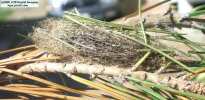

On 6-12-2005 these images were shot. Quite a few had spun cocoons by this time. They stoped eating and rested for 1-2 weeks before making a very lightweight cocoon. I expected that they would seek a low/dark place to pupate, but discovered that most of them preferred to pull semi-dried pine needles around them and pupate right on the host branch near where they had been feeding/resting. A number of them pupated together in groups, similar to their habit of resting in groups. Folds in the sleeves were also used. So far, none have burrowed into the pile of dried frass and pine needles that has accumulated at the bottom of the sleeves, indicating a preference NOT to be on or in the ground.


A few images of (very) mature larvae, taken 7-6-2005.
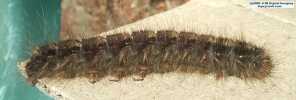



Here are a number of cocoon images, taken 7-6-2005. Note that the cocoons can be very well hidden in debris, or virtually spotless if made in the live host needles.






These images show not a yet pupated larva through the very thinly-spun cocoon. The cocoons were consistantly spun this thin, whether attached to live host needles, spun in the folds of the sleeve, or in debris at the bottom of the sleeve. 7-6-2005.


Here is a shot of a male pupa on 7-6-2005. The smaller size and larger antennae are indicators of gender.

By 7-6-2005, a number of adults had emerged, mated and laid eggs, so there were several different stages of the life cycle to be found at one point in time.
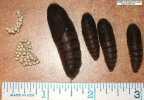
This is a scenting female in a small emerging cage, shortly after eclosure. 7-31-2005. Females turn on the scent in late afternoon and continue into the evening. This one was already scenting about 2 hours after eclosure.



Here is a mating pair in the small emerging cage. If males and females happen to emerge in the same afternoon, they don't waste any time getting down to business. In close confinement they'll mate any time from early afternoon to late evening, as soon as 30 minutes from the time they eclose. 7-22-2005

By 8-10-2005, most of the pupae had already emerged, while adults in the field have yet to be seen. Perhaps the indoor conditions where the pupae were kept spurred them into action earlier than normal, or maybe the wild populations have emerged earlier than last season, but are not flying in this area this season. By now, many of the ova from captive matings were hatching, making it a worm-fest on a massive scale!
On 8-13-2005, the first wild males were spotted. A few remaining captive females had eclosed and were waiting patiently. A few were taken outside to scent and eventually attracted a number of males. By 9-14-2005, the flight was well under way, with males regularly sighted all over the place in the afternoons and an ocassional wild female showed-up at the porch lights at dusk. There were so many larvae from earlier matings that I released hundreds of them on the pine trees in the backyard! I checked on the "free-range" larvae ocassionally to see how they were doing. Their numbers slowly dwindled over time, and the group(s) changed locations a number of time.
The images below were taken on 11-30-2005 and show one of the free-range groups clustered on the underside of a small branch. They eventually disappeared. Their fate, whether scattered, relocated to inaccessible areas or eaten by predators (probably!), is unknown.


Return To:
 SCV Butterflies |  Main Index Page |
